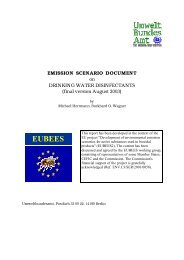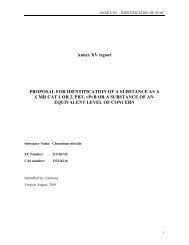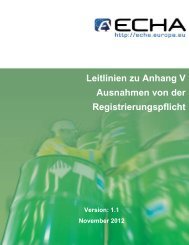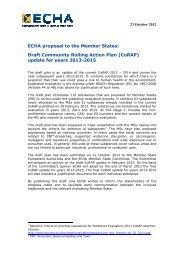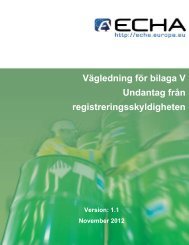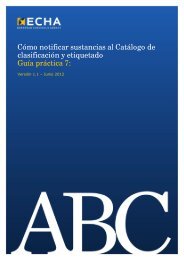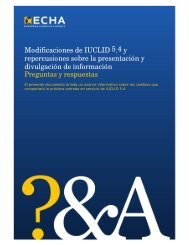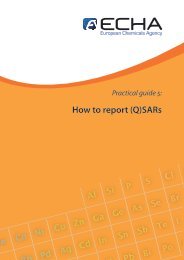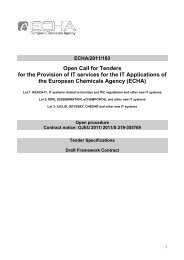Strategy For Limiting Risks Human Health Draft of ... - ECHA - Europa
Strategy For Limiting Risks Human Health Draft of ... - ECHA - Europa
Strategy For Limiting Risks Human Health Draft of ... - ECHA - Europa
You also want an ePaper? Increase the reach of your titles
YUMPU automatically turns print PDFs into web optimized ePapers that Google loves.
0 Summary<br />
Trisodium hexafluoroaluminate (Cryolite) is produced at four sites in the EU-15. In 2006 the<br />
production volume <strong>of</strong> these four sites was 23,561 t/a <strong>of</strong> which 11,500 t/a were exported. The<br />
volume for the European market was thus 12,061 t/a. Production capacity was provided by<br />
three companies and it makes 43,200 t/a.<br />
Synthetic cryolite can be obtained by reaction <strong>of</strong> hydr<strong>of</strong>luoric acid with aluminium hydroxide<br />
to form fluoroaluminium acid. After treating H3AlF6 with NaCl cryolite precipitates. In<br />
addition, H2SiF6 can be used as starting material in a similar reaction where the precipitated<br />
silicic acid is separated from the reaction solution.<br />
Cryolite is the main constituent <strong>of</strong> the electrolytic bath in the production <strong>of</strong> aluminium.<br />
During the electrolytic process cryolite is also formed as a by-product. EAA has provided an<br />
estimate <strong>of</strong> 24,000 t/a cryolite in the excess bath material produced at the European<br />
aluminium smelter sites.<br />
The main volume <strong>of</strong> intentionally produced cryolite is used as bath material in aluminium<br />
smelters. Cryolite is also used as filler in synthetic resins for abrasives and as binding agent<br />
for cutting or grinding discs. Minor uses are the use as opacifier in glass and enamel industry,<br />
in pyrotechnics and in ceramic industry.<br />
The classification <strong>of</strong> trisodium hexafluoroaluminate (cryolite) according to Annex I <strong>of</strong><br />
Directive 67/548/EEC (24 th ATP (98/73/EC), Index number: 009-016-00-2):<br />
T; R48/23/25 – Xn; R20/22 – N; R51-53.<br />
The following proposal for a harmonised classification and labelling was laid down in an<br />
Annex XV –Dossier:<br />
Proposed classification based on Directive 67/548/EEC:<br />
T; R48/23/25 – Xn; R20 – Xi; R36 - Repr.Cat.3; R63.<br />
Workers<br />
It has been concluded from the risk assessment that there is a need for limiting the risks due to<br />
repeated dose toxicity (local and systemic effects), and developmental toxicity. On the<br />
background <strong>of</strong> local effects in the airways air concentrations <strong>of</strong> cryolite dust at the workplace<br />
should be controlled to a level in the range <strong>of</strong> 0.1 mg/m 3 (critical exposure level for local<br />
effects after repeated exposure). In doing so also inhalation risks from other endpoints,<br />
especially systemic effects by fluorosis as result <strong>of</strong> repeated exposure and developmental<br />
toxicity are similarly and effectively mitigated.<br />
Special attention should be given to skin contact. The most critical effect again is repeated<br />
doses systemic toxicity (fluorosis). The critical exposure level is 92 mg/person/day (1.3<br />
mg/kg/day). In the assessment it was assumend that 10% <strong>of</strong> cryolite is absorbed through the<br />
skin. Considerable (but still practical) effort has to be taken within the framework <strong>of</strong><br />
workeplace legislation, in order to achieve the proposed level <strong>of</strong> dermal exposure. Dermal<br />
risk estimation might be refined by an additional suitable dermal absorption study.<br />
5






